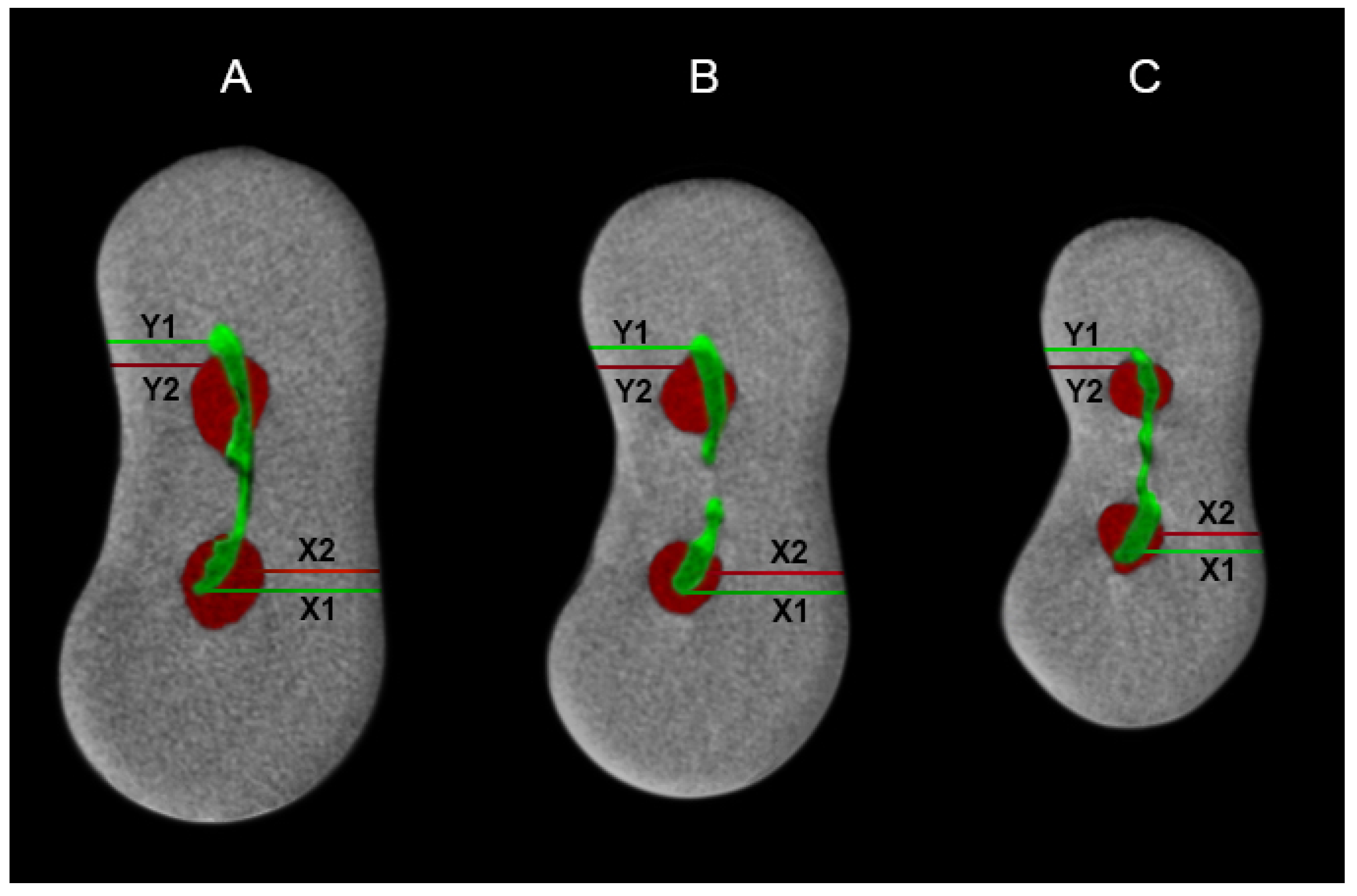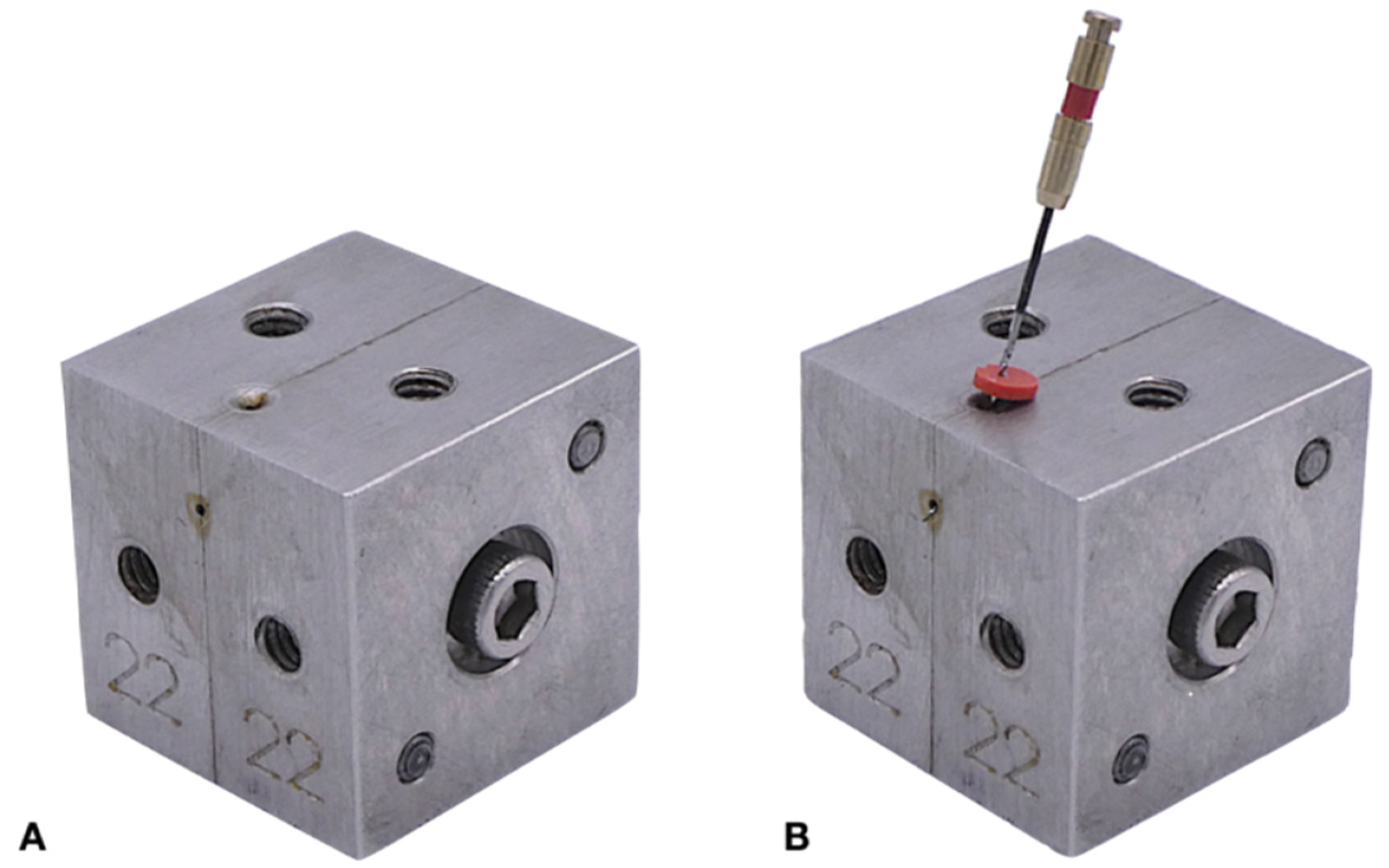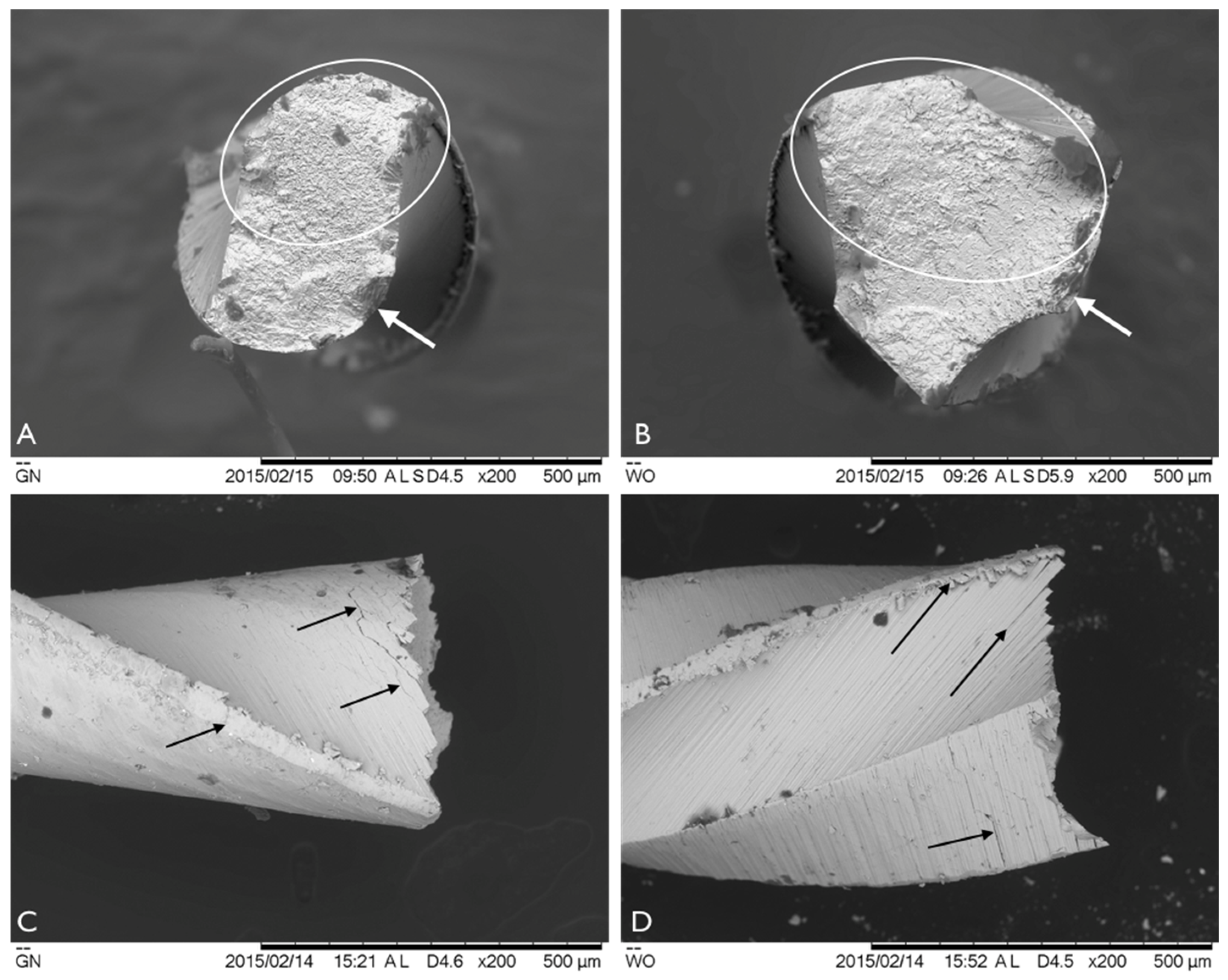Shaping Ability, Cyclic Fatigue Resistance and Fractographic Analysis of Hybrid and Reciprocating Nickel Titanium Endodontic Instruments
Abstract
:1. Introduction
2. Materials and Methods
2.1. Shaping Ability Evaluation
2.1.1. Sample Preparation
2.1.2. µCT Scanning and Data Analysis
2.2. Cyclic Fatigue Resistance Test
2.3. Fractographic Analysis
2.4. Statistical Analysis
3. Results
3.1. Shaping Ability Evaluation
3.2. Cyclic Fatigue Resistance Test
3.3. Fractographic Analysis
4. Discussion
5. Conclusions
Author Contributions
Funding
Acknowledgments
Conflicts of Interest
References
- Peters, O.A. Current challenges and concepts in the preparation of root canal systems: A review. J. Endod. 2004, 30, 559–567. [Google Scholar] [CrossRef] [PubMed] [Green Version]
- Loizides, A.L.; Kakavetsos, V.D.; Tzanetakis, G.N.; Kontakiotis, E.G.; Eliades, G. A comparative study of the effects of two nickel-titanium preparation techniques on root canal geometry assessed by microcomputed tomography. J. Endod. 2007, 33, 1455–1459. [Google Scholar] [CrossRef] [PubMed]
- Abou-Rass, M.; Frank, A.L.; Glick, D.H. The anticurvature filing method to prepare the curved root canal. J. Am. Dent. Assoc. 1980, 101, 792–794. [Google Scholar] [CrossRef] [PubMed]
- Gutmann, J.L.; Gao, Y. Alteration in the inherent metallic and surface properties of nickel-titanium root canal instruments to enhance performance, durability and safety: A focused review. Int. Endod. J. 2012, 45, 113–128. [Google Scholar] [CrossRef] [PubMed]
- Siqueira, J.F., Jr.; Alves, F.R.; Versiani, M.A.; Rocas, I.N.; Almeida, B.M.; Neves, M.A.; Sousa-Neto, M.D. Correlative bacteriologic and micro-computed tomographic analysis of mandibular molar mesial canals prepared by self-adjusting file, reciproc, and twisted file systems. J. Endod. 2013, 39, 1044–1050. [Google Scholar] [CrossRef]
- Zhao, D.; Shen, Y.; Peng, B.; Haapasalo, M. Micro-computed tomography evaluation of the preparation of mesiobuccal root canals in maxillary first molars with Hyflex CM, Twisted Files, and K3 instruments. J. Endod. 2013, 39, 385–388. [Google Scholar] [CrossRef]
- Drukteinis, S.; Peciuliene, V.; Dummer, P.H.M.; Hupp, J. Shaping ability of BioRace, ProTaper NEXT and Genius nickel-titanium instruments in curved canals of mandibular molars: A MicroCT study. Int. Endod. J. 2019, 52, 86–93. [Google Scholar] [CrossRef]
- Genius Reciprocating and Rotary Files; Genius Brochure; Ultradent products Inc.: South Jordan, UT, USA, 2016.
- Berutti, E.; Chiandussi, G.; Paolino, D.S.; Scotti, N.; Cantatore, G.; Castellucci, A.; Pasqualini, D. Canal shaping with WaveOne Primary reciprocating files and ProTaper system: A comparative study. J. Endod. 2012, 38, 505–509. [Google Scholar] [CrossRef] [Green Version]
- Stern, S.; Patel, S.; Foschi, F.; Sherriff, M.; Mannocci, F. Changes in centring and shaping ability using three nickel-titanium instrumentation techniques analysed by micro-computed tomography (µCT). Int. Endod. J. 2012, 45, 514–523. [Google Scholar] [CrossRef]
- Marzouk, A.M.; Ghoneim, A.G. Computed tomographic evaluation of canal shape instrumented by different kinematics rotary nickel-titanium systems. J. Endod. 2013, 39, 906–909. [Google Scholar] [CrossRef]
- Versiani, M.A.; Leoni, G.B.; Steier, L.; De-Deus, G.; Tassani, S.; Pecora, J.D.; de Sousa-Neto, M.D. Micro-computed tomography study of oval-shaped canals prepared with the self-adjusting file, Reciproc, WaveOne, and ProTaper universal systems. J. Endod. 2013, 39, 1060–1066. [Google Scholar] [CrossRef]
- Peters, O.A.; Laib, A.; Ruegsegger, P.; Barbakow, F. Three-dimensional analysis of root canal geometry by high-resolution computed tomography. J. Dent. Res. 2000, 79, 1405–1409. [Google Scholar] [CrossRef]
- Larsen, C.M.; Watanabe, I.; Glickman, G.N.; He, J. Cyclic fatigue analysis of a new generation of nickel titanium rotary instruments. J. Endod. 2009, 35, 401–403. [Google Scholar] [CrossRef]
- Marceliano-Alves, M.F.; Sousa-Neto, M.D.; Fidel, S.R.; Steier, L.; Robinson, J.P.; Pecora, J.D.; Versiani, M.A. Shaping ability of single-file reciprocating and heat-treated multifile rotary systems: A micro-CT study. Int. Endod. J. 2015, 48, 1129–1136. [Google Scholar] [CrossRef]
- De-Deus, G.; Belladonna, F.G.; Silva, E.J.; Marins, J.R.; Souza, E.M.; Perez, R.; Lopes, R.T.; Versiani, M.A.; Paciornik, S.; Neves Ade, E. Micro-CT Evaluation of Non-instrumented Canal Areas with Different Enlargements Performed by NiTi Systems. Braz. Dent. J. 2015, 26, 624–629. [Google Scholar] [CrossRef] [Green Version]
- Schneider, S.W. A comparison of canal preparations in straight and curved root canals. Oral Surg Oral Med. Oral Pathol. 1971, 32, 271–275. [Google Scholar] [CrossRef]
- Gambill, J.M.; Alder, M.; del Rio, C.E. Comparison of nickel-titanium and stainless steel hand-file instrumentation using computed tomography. J. Endod. 1996, 22, 369–375. [Google Scholar] [CrossRef]
- Gergi, R.; Arbab-Chirani, R.; Osta, N.; Naaman, A. Micro-computed tomographic evaluation of canal transportation instrumented by different kinematics rotary nickel-titanium instruments. J. Endod. 2014, 40, 1223–1227. [Google Scholar] [CrossRef]
- Azim, A.A.; Griggs, J.A.; Huang, G.T. The Tennessee study: Factors affecting treatment outcome and healing time following nonsurgical root canal treatment. Int. Endod. J. 2016, 49, 6–16. [Google Scholar] [CrossRef]
- Gergi, R.; Osta, N.; Bourbouze, G.; Zgheib, C.; Arbab-Chirani, R.; Naaman, A. Effects of three nickel titanium instrument systems on root canal geometry assessed by micro-computed tomography. Int. Endod. J. 2015, 48, 162–170. [Google Scholar] [CrossRef]
- Berutti, E.; Fedon, G. Thickness of cementum/dentin in mesial roots of mandibular first molars. J. Endod. 1992, 18, 545–548. [Google Scholar] [CrossRef]
- Setzer, F.C.; Kwon, T.K.; Karabucak, B. Comparison of apical transportation between two rotary file systems and two hybrid rotary instrumentation sequences. J. Endod. 2010, 36, 1226–1229. [Google Scholar] [CrossRef]
- Zhao, D.; Shen, Y.; Peng, B.; Haapasalo, M. Root canal preparation of mandibular molars with 3 nickel-titanium rotary instruments: A micro-computed tomographic study. J. Endod. 2014, 40, 1860–1864. [Google Scholar] [CrossRef]
- Paque, F.; Ganahl, D.; Peters, O.A. Effects of root canal preparation on apical geometry assessed by micro-computed tomography. J. Endod. 2009, 35, 1056–1059. [Google Scholar] [CrossRef] [Green Version]
- Wu, M.K.; R’Oris, A.; Barkis, D.; Wesselink, P.R. Prevalence and extent of long oval canals in the apical third. Oral Surg Oral Med. Oral Pathol Oral Radiol Endod. 2000, 89, 739–743. [Google Scholar] [CrossRef] [Green Version]
- Burklein, S.; Schafer, E. Apically extruded debris with reciprocating single-file and full-sequence rotary instrumentation systems. J. Endod. 2012, 38, 850–852. [Google Scholar] [CrossRef]
- Pedullà, E.; Lo Savio, F.; Boninelli, S.; Plotino, G.; Grande, N.M.; La Rosa, G.; Rapisarda, E. Torsional and Cyclic Fatigue Resistance of a New Nickel-Titanium Instrument Manufactured by Electrical Discharge Machining. J. Endod. 2016, 42, 156–159. [Google Scholar] [CrossRef]
- Hülsmann, M.; Donnermeyer, D.; Schäfer, E. A critical appraisal of studies on cyclic fatigue resistance of enginedriven endodontic instruments. Int. Endod. J. 2019, 52, 1427–1445. [Google Scholar] [CrossRef] [Green Version]
- De-Deus, G.; Vieira, V.T.; da Silva, E.J.; Lopes, H.; Elias, C.N.; Moreira, E.J. Bending resistance and dynamic and static cyclic fatigue life of Reciproc and WaveOne large instruments. J. Endod. 2014, 40, 575–579. [Google Scholar] [CrossRef]
- Plotino, G.; Testarelli, L.; Al-Sudani, D.; Pongione, G.; Grande, N.M.; Gambarini, G. Fatigue resistance of rotary instruments manufactured using different nickel-titanium alloys: A comparative study. Odontology 2014, 102, 31–35. [Google Scholar] [CrossRef]





| Group | n | Volume of Untreated Canal (mm3) | Volume of Removed Dentin (mm3) | Percentage of Unprepared Canal Surface |
|---|---|---|---|---|
| GN | 20 | 3.54 ± 1.26 | 2.14 ± 0.59 a | 41.66 ± 5.69 a |
| WO | 20 | 3.48 ± 1.12 | 2.61 ± 0.71 b | 45.52 ± 5.11 b |
| Group | n | Coronal Third | Middle Third | Apical Third |
|---|---|---|---|---|
| GN | 20 | 0.03 ± 0.02 a | 0.02 ± 0.01 a | −0.01 ± 0.04 a |
| WO | 20 | 0.05 ± 0.03 b | 0.04 ± 0.02 b | −0.04 ± 0.05 b |
| Measurements | n | Genius | WaveOne |
|---|---|---|---|
| NCF | 20 | 2141.53 ± 473.38 a | 1583.02 ± 444.35 b |
| Length of the fragment (mm) | 20 | 4.35 ± 0.43 | 4.12 ± 0.82 |
© 2020 by the authors. Licensee MDPI, Basel, Switzerland. This article is an open access article distributed under the terms and conditions of the Creative Commons Attribution (CC BY) license (http://creativecommons.org/licenses/by/4.0/).
Share and Cite
Drukteinis, S.; Peciuliene, V.; Bendinskaite, R.; Brukiene, V.; Maneliene, R.; Nedzinskiene, E. Shaping Ability, Cyclic Fatigue Resistance and Fractographic Analysis of Hybrid and Reciprocating Nickel Titanium Endodontic Instruments. Metals 2020, 10, 172. https://doi.org/10.3390/met10020172
Drukteinis S, Peciuliene V, Bendinskaite R, Brukiene V, Maneliene R, Nedzinskiene E. Shaping Ability, Cyclic Fatigue Resistance and Fractographic Analysis of Hybrid and Reciprocating Nickel Titanium Endodontic Instruments. Metals. 2020; 10(2):172. https://doi.org/10.3390/met10020172
Chicago/Turabian StyleDrukteinis, Saulius, Vytaute Peciuliene, Ruta Bendinskaite, Vilma Brukiene, Rasmute Maneliene, and Egle Nedzinskiene. 2020. "Shaping Ability, Cyclic Fatigue Resistance and Fractographic Analysis of Hybrid and Reciprocating Nickel Titanium Endodontic Instruments" Metals 10, no. 2: 172. https://doi.org/10.3390/met10020172






